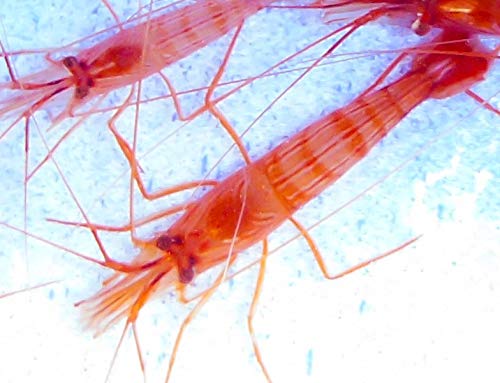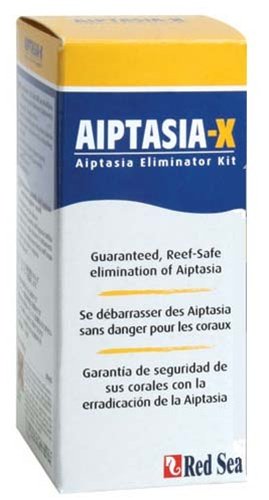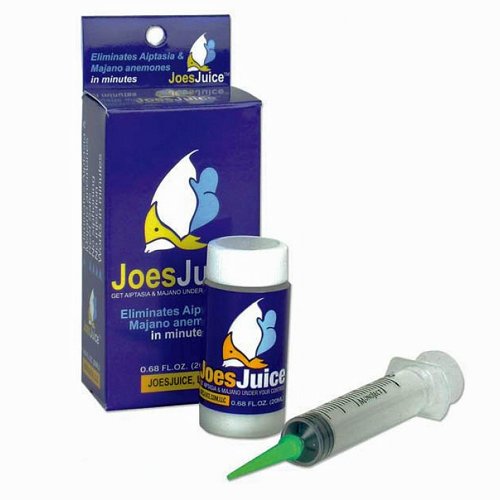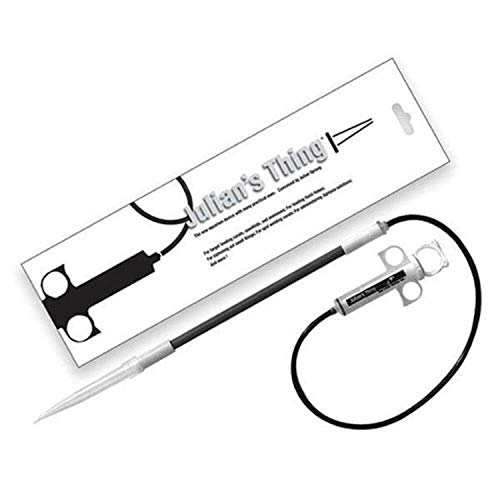how to get rid of aiptasia
You could be the world's best aquarist and still have your run-ins with different aquarium pests. One of the most common pests is the Aiptasia anemone and chances are you will run into them at least once in your time in the hobby.
Don't let that discourage you though! It just means that you need to know what to do when they inevitably show up and with quick action, you can keep your saltwater aquarium in tip-top shape.
How To Get Rid Of Aiptasia
The most effective way to remove Aiptasia from a saltwater aquarium is by using predators like Peppermint Shrimp. Try to find ones that are captive-bred and raised eating Aiptasia for the best results.
Best Methods For Getting Rid Of Aiptasia
Peppermint Shrimp

Hands down, the best method of removing Aiptasia is peppermint shrimp.
Aiptasia-X

Great for killing larger Aiptasia that peppermint shrimp won't eat.
Joe's Juice

An excellent alternative for killing Aiptasia peppermint shrimp won't eat.
Julian's Thing

A better syringe for getting at difficult to reach Aiptasia anemones.
What is Aiptasia?
Aiptasia is a parasitic anemone that can rapidly multiply within your tank and cause havoc. They have a stinger like other species of anemone, but the toxins released by these reef critters are much more harmful to coral. These sting does not kill your coral immediately, but you should act fast to prevent the loss of your coral altogether. Like previously mentioned, these pests can multiply quickly within your tank, so it is best to take action as soon as you become aware that they are in your saltwater tank.
Besides hurting the coral and other inhabitants of your reef tank, these little pests can reproduce sexually or asexually which is why it can be risky to leave even one in your tank for too long. The way that they can reproduce asexually sounds like something out of a science fiction movie because, as they move around your tank, pieces of them can come off and begin to grow into their own organisms.
To make matters even worse, these little guys can move around your tank and can fit in the tiniest crevices. Their ability to hide up in tiny caves and holes helps to make them an even more formidable foe. Combine all these attributes and you can understand why you need to be careful when you begin to attempt to get rid of Aiptasia from your tank.
What does Aiptasia look like?
Aiptasia has a brown dull color to it that is not a very pleasant addition to your reef tank. They are sometimes referred to as "a brown palm tree" but I would say those palm trees are having a bad hair day if that is the case. Some species might have a more transparent hue to them as well so be on the lookout. These little pests are not attractive so you should be able to see them sticking swaying in the flow of your tank.
Majano anemone
NOTE: there is another species of anemone, the Majano anemone, that can be mistaken for Aiptasia. The biggest indicator to tell the two apart is that Majno is larger and has brighter colors. However, you mustn't try to treat these two with the same method of removal and care. You might need to change up your tactics if you suspect that your pest is a Majano.
How does Aiptasia get into my reef tank?
Aiptasia, like many other pests, hitchhikes into your tank on live rock and sometimes coral. You want to be careful when introducing new live rock and other reef pieces to your tank so should be inspecting each one carefully and thoroughly. However, there might be times where you miss something and an organism like an Aiptasia anemone gets into your tank but that's okay as long as you are monitoring your tank and ready to take appropriate action.
How to prevent Aiptasia
The easiest way to deal with an outbreak in your tank is by inspecting all the live rock and coral that you plan to introduce to it. That might seem like common sense but with a careful inspection, you are decreasing your chances of an outbreak in your reef aquarium considerably. However, even a careful inspection of your live rock isn't full proof. There is still a chance you missed a minuscule piece of Aiptasia and that is all that is needed for an infestation to begin.
You could always try to place all your live rock in a separate tank to observe it for a few days if you wanted to be very careful. However, that is up to you and if you have natural predators available in your display tank then it might not be as crucial for you to spot every single piece of Aiptasia tissue. Once you are sure that every piece is free of all Aiptasia Anemones feel free to begin to introduce that rock to your display tank.
If you do spot a hitchhiker on your live rock feel free to try one of the methods below to remove it completely. Since the rock is not currently in your display tank's water it might be easier to apply chemical methods to it or brute force if you get it all. The chances of one sneaking in are high though since they are experts at concealing themselves when they feel they are in danger. I can think of few times that could feel as dangerous as a stranger picking up my home and twisting it this and that looking for me. A keen eye will pick up on some of the possibly concealed Aiptasia but it is more than likely you will miss one day.
How to remove Aiptasia
We know how to identify Aiptasia Anemones now, but we also know that they can multiply just by losing pieces of themselves. How you remove the unwanted anemone is crucial to ensuring that the job is done effectively, and you won't be scraping around in your tank for the rest of the century You want a method that will capture the Aiptasia without causing the creature to break off or tear apart as that will only increase the population of the pest.
What will kill Aiptasia anemones?
Peppermint Shrimp
The best creature to consider for your reef aquarium is a Peppermint Shrimp. These little red shrimps have a huge hankering for Aiptasia so they will hunt them down to the corners of your tank. My own personal experience dealing with Aiptasia anemone is that Peppermint Shrimp are by far the most effective solution. They enthusiastically eat Aiptasia as they find them and can deal with any new Aiptasia that is produced from the leftovers. Peppermint Shrimp don't typically eat the largest Aiptasia so those may need to be dealt with another method (see above).
Sometimes Peppermint Shrimp won't eat Aiptasia Anemones but from my own experience, they have been consistent in dealing with Aiptasia. If you get some shrimp and they don't solve the problem, I suggest trying again and sourcing them from a different local fish store or online because some shops will actually feed their Peppermint Shrimp Aiptasia. This helps predispose the shrimp to eat them as their primary food source. It is also possible that some fish shops sell what they call "Peppermint Shrimp" but is a similar shrimp under the same name.
It isn't nearly as standardized as it could be so be cynical of the name when shopping. Do your research and make sure that the shrimp you are introducing to your saltwater tank is safe for your corals. If by chance they are not, you can still use one, but you will need to monitor it carefully and remove it when you believe that all the Aiptasiahas been eaten.
Copperbanded Butterflyfish
You can also consider a Copperbanded Butterflyfish, which is another natural predator of Aiptasia. I wouldn't go out of my way to find these fish solely to deal with your Aiptasia infestation but if you were already planning on including these fish in your reef tank then it might be a win-win. In the same vein, Berghia Nudibranch does eat Aiptasia but they are expensive and eat Aiptasia slowly.
Aiptasia Eating Filefish
Another natural predator that will help get rid of your problematic Aiptasia outbreak is the Aiptasia Eating Filefish. The Filefish should be used in large tanks but know that if they are not appropriately supplied with the food they might terrorize other inhabitants of your tank. They have been known to nibble at corals and attack fish that are smaller than themselves. Make sure you are prepared to care for these fish beyond the initial outbreak of Aiptasia as it might become more of a pest itself if not properly cared for.
Hermit Crabs
Many people swear by the success of hermit crabs, specifically the white-spotted hermit crab, in hunting down Aiptasia. However, there are accounts that Aiptasia will fight back against hermit crabs that are already weak or too young to put up an appropriate fight. If you decide to try to introduce hermit crabs to fight your Aiptasia infestation just know that they are not as tried and true as the Peppermint Shrimp.
Other methods to consider
You can help control the population of Aiptasia Anemones in your tank in several other ways as well but keep in mind each method will have its own pros and cons depending on the type of saltwater aquarium setup you have. Take the time to weigh the risks and what might be best for your particular setup. Ideally, you would have found success with some of the natural predators we discussed earlier in the article but if that is not the case the following methods can be worth trying.
Lemon juice
You can attempt to kill the anemone with a syringe filled with lemon juice. Lemon juice is acidic though and will disturb the water quality of your tank. If you decide to follow through with this method, you need to approach the Aiptasia slowly so as not to scare it and inject it with the lemon juice. You need to monitor the water quality measurements and the tank's ecosystem's reaction to ensure that your tank's inhabitants are fairing okay with the method.
Superglue
If you think you only have one Aiptasia, you MIGHT be able to remove the rock they are hiding in causing them to try to hide in a small crevice. You can try to trap them with glue in their hiding place and they will slowly starve to death. Again, this doesn't seem like a great idea if you even think there might be more than one. It isn't worth the hassle and it would be better for you to invest your time and energy into another method that can deal with multiple Aiptasia at a time.
Majano Wand
I am unsure if this method kills all of the Aiptasia but it is another reported method that I thought relevant to share. The method uses the electronic wand to disintegrate the Aiptasia on contact. It could work but like most other methods you need to be careful that you are not injuring the other creature in your tank with the wand. You will also need to take care to get all the Aiptasia as leaving any will only let them come back with a vengeance. You also need to consider how large of an infestation you are trying to eradicate. The wand is used on individual specimens so the more you have the more time it is going to take you to try to rid your tank. If you miss one, you wasted an entire afternoon. Of course, the biggest issue with this method is that it is expensive. There are much cheaper and potentially more effective methods that you should consider before attempting to use this method, especially with a large outbreak.
Boiling water
There are reports of people using boiling water to remove Aiptasia. People boil water and use a syringe to spray the Aiptasia. However, for every person that swears by this method, a person is saying that it isn't effective. It might be a good idea to try this method if the above methods haven't worked and you are considering a chemical solution.
Chemicals (Aiptasia-X, Hydrogen Peroxide, etc.)
You might consider going with a chemical solution that targets Aiptasia specifically. As you might already be thinking, there are some risks with a chemical treatment approach. Adding any chemicals to your saltwater aquarium is usually not recommended and it is the same with these kinds of treatments as you do know how it will affect the rest of your aquarium. You want to check that the chemical you are introducing into your tank will not hurt your fish or corals. That would sure be a waste of your efforts if that happened!
Typically, this method is a last resort after you tried other safer methods. It requires that you to inject the Aiptasia with a chemical that is specifically designed to kill them but as you can imagine that is easier said than done. The Aiptasia can and will move away from you as you attempt to inject them. At the end of the day, after you perform this method, you will need to watch your tank to see how your fish and corals hold up. If they are not handling the presence of the chemical well, you will need to do some water changes to remove the toxin from the water.
You can also try hydrogen peroxide as another option for killing the pests. You will need a plastic syringe and food-grade hydrogen peroxide to administer. It will do the job when injected into the Aiptasia but it can hurt any of the nearby organisms as well. It is best to use this method when it is an isolated specimen so if you can't guarantee that the hydrogen peroxide won't upset the coral and fish nearby then it might be best to hold off on this method.
Another product available is Aiptasia X which can kill Aiptasia but you still run the risk of the Aiptasia multiplying or releasing spores. This product is supposed to essentially "glue" the mouth of the anemone shut when injected to prevent the release of spores but it is extremely difficult to do without spores being released. Although this can work well on large Aiptasia if you have Peppermint Shrimp that won't eat larger anemones. I recommend the Aiptasia X product over these methods based on my personal experience.
Methods that are best avoided
Bleach
It might seem like common sense, but bleach is extremely toxic to pretty much everything. No matter how diluted you try to make this chemical you are putting all the inhabitants of your tank at risk. There is no reason for that when there are much safer methods for removing the pest. We are trying to find the safest and most sure-fire methods for ridding ourselves of Aiptasia and bleach is not at the top of that safety list.
Brute force
It may seem appealing and easy to simply reach in with your hand, tweezers, or other choice tool but the chances of you causing more harm than good are high. It won't end well. You might feel good about your perceived accomplishment for a little bit but I promise you that you did not get all of the Aiptasia from your tank. Instead, all you did was send dozens of babies to potentially grow and multiply throughout your tank. It really isn't worth it.
Laser
Initially, the laser method might seem like the coolest and thus the most interesting method to try to get rid of your Aiptasia outbreak. This method uses a high-powered laser to kill Aiptasia but it runs several risks in doing so. First, there is the personal injury that could result from using this device. Imagine the risks of a normal laser pointer which can harm people's vision and multiply that by like 20 and that is what you are working with. You want to take the proper precautions and make sure you are in a secure area before you begin to use this device. There is even some debate about whether the laser should be sued through the glass of your reef aquarium so to reduce the risk you should clean the glass thoroughly before you begin to use the laser. Plus, this method is much more expensive than the electric wand but even more dangerous to yourself and potentially your reef aquarium. It is best to just avoid this method at least for the time being. Maybe in the future, there will be a safer and more effective laser specifically for Aiptasia.
Final thoughts
There are a number of ways to try to tackle anaplasia infestation, but you should consider which method you want to employ carefully. You want to ask yourself several questions like how large is the infestation? Do I need where all the Aiptasia are? How will my reef tank react to the method I employ? Even after you choose your method, the task will not be easy. The pests are resilient and very difficult to ensure that all traces of the species has been removed from the tank. Make your plan of attack and monitor your tank closely as it probably won't be cleaned up in a single day but the more care you take the higher the chance for success. It isn't a job well done until all the Aiptasia are gone in your reef aquarium. Don't worry it's all' a part of the hobby and it's just another hurdle you will overcome.
how to get rid of aiptasia
Source: https://reeftankresource.com/how-to-get-rid-of-aiptasia-permanently/#:~:text=The%20most%20effective%20way%20to,Aiptasia%20for%20the%20best%20results.
Posted by: reedroon1964.blogspot.com

0 Response to "how to get rid of aiptasia"
Post a Comment